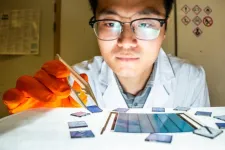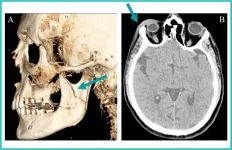(Press-News.org) Genome editing with various CRISPR-Cas molecule complexes has progressed rapidly in recent years. Hundreds of labs around the world are now working to put these tools to clinical use and are continuously advancing them.
CRISPR-Cas tools allow researchers to modify individual building blocks of genetic material in a precise and targeted manner. Gene therapies based on such gene editing are already being used to treat inherited diseases, fight cancer and create drought- and heat-tolerant crops.
Starting the repair
The CRISPR-Cas9 molecular complex, also known as genetic scissors, is the most widely used tool by scientists around the world. It cuts the double-stranded DNA at the exact site where the genetic material needs to be modified. This contrasts with newer gene editing methods, which do not cut the double strand.
The cut activates two natural repair mechanisms that the cell uses to repair such damage: a fast but imprecise one that reconnects only the ends of the cut DNA, and a slow and precise one that is slow and thorough but not activated in every case. The latter requires a copyable template for repair to accurately rejoin the DNA at the cut site.
The slow variant is called homology-directed repair. Researchers want to use this method of repair because it allows the precise integration of individual DNA segments into a desired gene region. The approach is very flexible and can be used to repair different disease genes. “In principle, it could be used to cure any disease,” says Jacob Corn, Professor of Genome Biology at ETH Zürich.
Boosting efficiency with one molecule
To get the cell to use homology-directed repair, the researchers recently began using a molecule called AZD7648, which blocks fast repair and forces the cell to use homology-directed repair. This approach is expected to accelerate the development of more efficient gene therapies. Initial studies with these new therapies have been good. Too good to be true, as it turned out.
A research group led by Jacob Corn has just discovered that the use of AZD7648 has serious side effects. The study has just been published in the journal Nature Biotechnology.
Massive genetic changes
Although AZD7648 promotes precise repair and thus precise gene editing using the CRISPR-Cas9 system as hoped, in a significant proportion of cells this has led to massive genetic changes in a part of the genome that was expected to be modified without scarring. The ETH researchers found that these changes resulted in the simple deletion of thousands and thousands of DNA building blocks, known as bases. Even whole chromosome arms broke off. This makes the genome unstable, with unpredictable consequences for the cells edited by the technique.
“When we analysed the genome at the sites where it had been edited, it looked correct and precise. But when we analysed the genome more broadly, we saw massive genetic changes. These are not seen when you only analyse the short, edited section and its immediate neighbourhood,” says Grégoire Cullot, a postdoctoral fellow in Corn’s group and first author of the study.
Extent of damage is large
The extent of the negative effects surprised the researchers. In fact, they suspect that they do not yet have a complete picture of the full extent of the damage because they did not look at the entire genome when analysing the modified cells, only partial regions.
New tests, approaches and regulations are therefore needed to clarify the extent and potential of the damage.
The molecule AZD7648 is not unknown. It is currently in clinical trials as a potential cancer treatment.
But how did the ETH researchers become aware of the problem? In other studies, the researchers showed how highly effective and precise CRISPR-Cas9 gene editing is when AZD7648 is added. “This made us suspicious, so we took a closer look,” says Jacob Corn.
The ETH researchers then analysed the sequence of DNA building blocks not only around the edited site but also in the wider environment. They discovered these unwanted and catastrophic side effects caused by using AZD7648.
Their study is the first to describe these side effects. Other research groups have also investigated them and support the ETH researchers’ findings. They also aim to publish their results. “We are the first to say that not everything is wonderful,” says Corn. “For us, this is a major setback because, like other scientists, we had hoped to use the new technique to accelerate the development of gene therapies.”
The beginning of something new
Nevertheless, Corn says this is not the end but the beginning of further advances in gene editing using CRISPR-Cas techniques. “The development of any new technology is a rocky road. One stumble does not mean we give up on the technology.”
It may be possible to avert the danger by using not just one molecule to promote HDR in the future but a cocktail of different substances. “There are many possible candidates. We now need to find out which components such a cocktail would have to consist of in order not to damage the genome.”
Gene therapies based on the CRISPR-Cas system have already been successfully used in clinical practice. In recent years, for example, a hundred patients suffering from the hereditary disease sickle cell anaemia have been treated with CRISPR-Cas-based therapeutics – without AZD7648. “All patients are considered cured and have no side effects,” says Corn. “So, I am optimistic that gene therapies like this will become mainstream. The question is which approach is the right one and what we need to do to make the technique safe for as many patients as possible.”
END
CRISPR-Cas technology: Balancing efficiency and safety
2024-12-04
ELSE PRESS RELEASES FROM THIS DATE:
Preventing brain injury complications with specialized optical fibers
2024-12-04
Fiber optics are a means of transmitting information at incredibly high speeds; however, the technology can be used for more than just providing a fast internet connection. Researchers reporting in ACS Sensors have developed an optical fiber sensing system that could help medical professionals monitor patients for complications after a traumatic brain injury. The technology tracks six biomarkers simultaneously, continuously and automatically to provide crucial information on brain health in lab tests.
After a traumatic brain injury, such as a concussion, secondary damage can occur from swelling in the brain. Biomarkers found in blood or spinal fluid provide medical professionals ...
New effort to improve care for hidden heart disease
2024-12-04
DALLAS, December 4, 2024 — An estimated 1 in 500 people in the U.S. are living with hypertrophic cardiomyopathy (HCM) — the most common inherited heart disease — and many are unaware.[1]
HCM is a thickening of the lower main pumping chamber of the heart (the left ventricle). The disease is often underdiagnosed and inconsistently managed, leading to delayed treatment, increased risk of complications and preventable death. Yet, systems of care for this disease are fragmented and varied.
To overcome these gaps in care, the American Heart Association, celebrating a century of lifesaving service in 2024, has launched a new three-year initiative to ...
AI helps researchers dig through old maps to find lost oil and gas wells
2024-12-04
Scattered across the United States are remnants from almost 170 years of commercial drilling: hundreds of thousands of forgotten oil and gas wells. These undocumented orphaned wells (UOWs) are not listed in formal records, and they have no known (or financially solvent) operators. They are often out of sight and out of mind – a hazardous combination.
If the wells weren’t properly plugged, they can potentially leak oil and chemicals into nearby water sources or send toxic substances like benzene and hydrogen sulfide into the air. They can also contribute ...
Study finds perceptions of parent cannabis use shape teen attitudes
2024-12-04
PULLMAN, Wash. — Teens who think their parents use cannabis are more likely to hold favorable attitudes toward the drug and to consider trying it themselves, according to a new Washington State University study.
The research, published in the Journal of Child and Family Studies, also reveals that parental monitoring and the closeness of parent-child relationships play crucial roles in adolescents’ views about cannabis, often with distinct effects based on the parent’s gender.
The ...
$230K grant awarded to The Jackson Laboratory (JAX) to advance translational research on SYNGAP1-Related Disorders
2024-12-04
Mill Valley, CA – December 4, 2024 – The SynGAP Research Fund (SRF) has awarded a $230,000 grant to The Jackson Laboratory Rare Disease Translational Center to characterize a mouse model for SYNGAP1-Related Disorders, (SRD), a severe neurodevelopmental disorder marked by seizures, intellectual disabilities, and motor and behavioral challenges.
This work, under Matthew Simon Ph.D., senior study director and lead scientist at The Jackson Laboratory (JAX), will focus on the characteristics of the SYNGAP1-Q503X mouse model, which mirrors a specific patient variant of SRD.
A key SRF partner, Tevard Biosciences, will use the SYNGAP1-Q503X ...
Predicting diabetes via clinical and genetic data research team registered patent for diabetes prediction system
2024-12-04
Predicting Diabetes via Clinical and Genetic Data
Research Team Registered Patent for Diabetes Prediction System
- Predicting 5-year risk of type 2 diabetes with deep learning algorithms
-Anticipating benefits of personalized early diagnosis and prevention strategies
A research team led by professor Nan-Hee Kim from Korea University's College of Medicine (Nan-Hee Kim and So-Young Park of Department of Endocrinology and Metabolism; Min-Hee Kim and Jae-Young Kim of Health Science Research Center) recently developed ...
How non-toxic and efficient solar cells can be produced
2024-12-04
Large-scale production of organic solar cells with high efficiency and minimal environmental impact. This can now be made possible through a new design principle developed at Linköping University, Sweden. In the study, published in the journal Nature Energy, the researchers have studied molecule shape and interaction in organic solar cells.
“With electrification and the development of AI, we will probably see a significant increase in the world’s energy needs. That electricity needs to come from environmentally sustainable sources if we are to slow down climate change at the same time,” says Feng Gao, professor of optoelectronics at LiU.
One green ...
Eating high-processed foods impacts muscle quality
2024-12-04
CHICAGO – A diet high in ultra-processed foods is associated with higher amounts of fat stored inside thigh muscles, regardless of the amount of calories consumed or level of physical activity, according to a study being presented today at the annual meeting of the Radiological Society of North America (RSNA). Higher amounts of intramuscular fat in the thigh could also increase the risk for knee osteoarthritis.
The use of natural and minimally processed ingredients in many modern diets has decreased, more often being replaced with ingredients that have been industrially processed, artificially flavored, colored or chemically altered.
Foods ...
Study Exposes High Injury Rates in Transgender Women
2024-12-04
CHICAGO – A new study found that injury rates among transgender women are significantly higher than injuries among cisgender women, based on radiological imaging. The findings will be presented today at the annual meeting of the Radiological Society of North America (RSNA).
‘Cisgender’ is a term used to describe people whose gender identity matches the sex they were assigned at birth, while ‘transgender’ describes people whose gender identity differs from the sex they were assigned ...
Massive asteroid impacts did not change Earth’s climate in the long term
2024-12-04
Two massive asteroids hit Earth around 35.65 million years ago, but did not lead to any lasting changes in the Earth’s climate, according to a new study by UCL researchers.
The rocks, both several miles wide, hit Earth about 25,000 years apart, leaving the 60-mile (100km) Popigai crater in Siberia, Russia, and the 25-55 mile (40-85km) crater in the Chesapeake Bay, in the United States - the fourth and fifth largest known asteroid craters on Earth.
The new study, published in the journal Communications Earth & Environment, found no evidence of a lasting shift in climate in the 150,000 years that followed the impacts.
The researchers inferred the past climate ...






